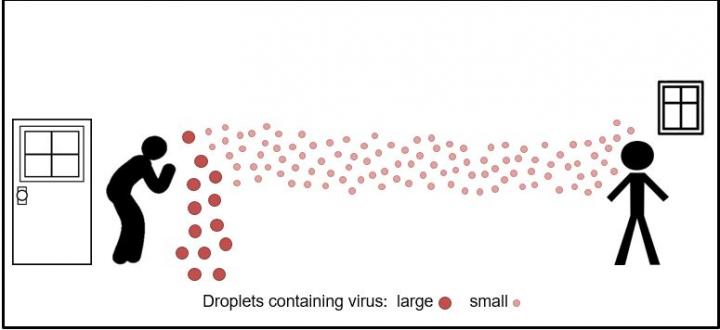Researchers are urging health authorities to immediately recognise the role of airborne transmission of COVID-19 virus droplets from an infected person beyond 1.5m in order to stem the disease’s spread

Credit: QUT: Chantal Labbe
World-leading air quality and health expert QUT Professor Lidia Morawska and Professor Junji Cao from Chinese Academy of Sciences in an article in Environment International published this week called on health bodies to initiate research into the airborne transmission of COVID-19 as it is happening
“National health bodies responsible for controlling the pandemic are hampered by not acknowledging the research evidence of airborne transmission of viable virus droplets, that was conducted after the SARS 2003 outbreak,” Professor Morawska said.
“Now is the ideal time to conduct research into how viruses can travel on the airflow, because there are many similarities between the coronavirus that caused SARS and the COVID-19 coronavirus and therefore it is highly likely that COVID-19 spreads by air.
“Analysis of the initial pattern of COVID-19 spread in China reveals multiple cases of non-contact transmission, especially in areas outside Wuhan.
“On numerous cruise ships where thousands of people onboard were infected, many of the infections occurred after passengers had to isolate in their cabins even though hand hygiene was implemented.
“Therefore, the ventilation system could have spread the airborne virus between the cabins.
“We know that Covid-19’s predecessor, SARS.CoV-1, did spread on the air in the 2003 outbreak. Several studies have retrospectively explained this pathway of transmission in Hong Kong’s Prince of Wales Hospital as well as in healthcare facilities in Toronto, Canada.
“A WHO review (2009) of the evidence found viral diseases can be transmitted across distances in indoor environments by aerosol or airborne infection and can result in large clusters of infection in a short period.”
Professor Morawska said authorities need to put in place public health precautions to lower airborne transmission by:
- increased ventilation of indoor spaces
- use of natural ventilation
- avoiding air recirculation
- avoiding staying in another person’s direct air flow
- minimizing the number of people sharing the same environment
- providing adequate ventilation in nursing homes, hospitals, shops, offices, schools, restaurants and cruise ships.
Professor Morawska said virus droplets’ liquid content started to evaporate immediately after being exhaled and some became so small that could travel on air currents, rather than fall to the ground as larger droplets do.
“Such small droplets can carry their viral content metres, even tens of metres, away from the infected person.”
Professor Morawska said it was difficult to directly detect viruses travelling in the air because it took knowledge of the air flow from an infected person and a long sampling period to collect enough copies of the viruses.
“Air transmission research should be undertaken now and its likelihood as a means of spread should be taken seriously with due precautions taken now.
“We have already lost valuable time by ignoring this method of spread and we should act on the presumption that COVID-19 is spreading on the air.”
###
“Airborne transmission of SARS-CoV-2: The world should face the reality”, was published in Environment International.
Media Contact
Niki Widdowson
[email protected]
Original Source
https:/
Related Journal Article
http://dx.




